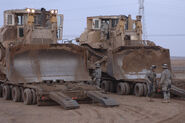| This article needs additional citations for verification. Please help improve this article by adding citations to reliable sources. Unsourced material may be challenged and removed. (February 2011) |
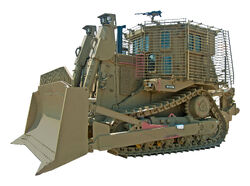
An armored IDF Caterpillar D9R bulldozer, nicknamed "דובי" (Teddy bear) in Israel.
Its armor allows it to work under heavy fire.
The armoured bulldozer (Armored bulldozer - US spelling) is a basic tool of combat engineering. These combat engineering vehicles combine the earth moving capabilities of the bulldozer with armor which protects the vehicle and its operator in or near combat. Most are civilian bulldozers modified by addition of vehicle armor/military equipment, but some are tanks stripped of armament and fitted with a dozer blade. Some tanks have bulldozer blades while retaining their armament, but this does not make them armored bulldozers as such, because combat remains the primary role — earth moving is a secondary task.
World War 2[]
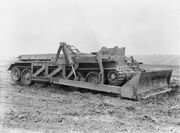
Centaur bulldozer

British D7 World War 2 armored bulldozer.

Preserved armoured D7 with millitary crane based on a dozer behind
The first armored bulldozer was developed by the British during World War 2. This was a conventional Caterpillar D8 bulldozer fitted with armor to protect the driver and the engine. The work was carried out by Jack Olding & Company Ltd of Hatfield. The bulldozer was one of several strange armored vehicles that were collectively referred to as "Hobart's Funnies" and were operated by the British 79th Armoured Division in support of armored assaults.
The bulldozers were produced in preparation for the Battle of Normandy with the tasks of clearing the invasion beaches of obstacles and quickly making roads accessible by clearing rubble and filling in bomb craters.
As allied armies advanced through Europe, the armored bulldozer was found to be too slow—there was a need for well-armored, obstacle clearing vehicle that was fast enough to keep up with tank formations. This need was met by the Centaur Bulldozer—a Centaur tank with the turret removed and a bulldozer blade fitted. Centaur bulldozers were still in use with the British Army at the time of the Korean War.
Modern usage[]

Armored bulldozer of Serbian armed force
Modern armored bulldozers are often based on the Caterpillar D9 and D7.
Caterpillar does not manufacture a military version of the D9 and D7 per se, but the attributes that make the D9 popular for major construction projects make it desirable for military applications as well. It has been particularly effective for the Israel Defense Forces (IDF) and for the United States armed forces (the Marine Corps and the US Army) in Iraq.
Israeli usage[]
- See also: IDF Caterpillar D9
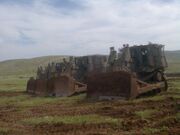
IDF D9R with slat armor.
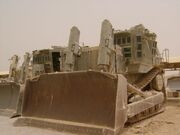
IDF D9L, involved in the Battle of Jenin 2002 during Operation Defensive Shield.
The Israeli Armored D9 — nicknamed Doobi (Hebrew: דובי; lit. teddy bear) — is a Caterpillar D9 bulldozer that was modified by the Israel Defence Forces, Israeli Military Industries and Israel Aerospace Industries to increase the survivability of the dozer in hostile environments and enable it to withstand heavy attacks.
The D9R, the latest generation of D9 bulldozers in IDF service, has a power of 405 to 410 horsepower (302 to 306 kW) and drawbar pull of 71.6 tonnes-force (702 kN). It has a crew of two, an operator and a commander. It is operated by the, Mechanical Engineering Equipment) units of the Israeli Engineering Corps.
The main IDF modification is the installation of an Israeli-made armor kit which provides armor protection to the mechanical systems and to the operator cabin. The operator and commander are protected inside an armored cabin ("the cockpit"), with bulletproof windows to protect against bombs, machinegun, and sniper fire. The IDF also developed a slat armor add-on to deflect RPG rounds. The fitted armor package adds roughly 15 additional tons to the production-line weight of the D9. The modified D9 bulldozers can be fitted with other features, such as crew-operated machine guns, smoke projectors, or grenade launchers.
The IDF uses the D9 for a wide variety of engineering tasks, most notably home & structure demolition, even if under fire, as well as earthworks, digging moats, mounting sand barriers, building fortifications, rescuing stuck, overturned or damaged armored fighting vehicles (along with M88 Recovery Vehicle), clearing landmines, detonating IEDs and explosives, clearing terrain obstacles and opening routes for armored fighting vehicles and infantry.
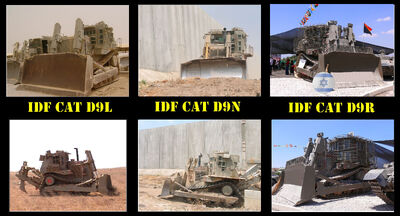
Different armored Caterpillar D9 generations in IDF service.
From left to right: D9L (460 hp, drawbar pull 75 tons ), D9N (375-401 hp), D9R (410 hp, drawbar pull 71.6 tons).
United States usage[]
During the first Gulf war the USA purchased tractor protection kits (TPK) from the Israel Military Industries (IMI) for their Caterpillar D7 bulldozers.[citation needed] The armored bulldozers were mainly used in mine clearing applications. During the preparation to the war in Iraq in 2003 the United States Army purchased several D9 armor kits from the IDF and used them to produce similarly fortified D9s. These have been used to clear destroyed vehicles from roads, dig moats, erect earthen-barriers, and construct field fortifications. D9s have also been used to raze houses which sheltered insurgent snipers. Military reports on the Conflict in Iraq say that the D9s were found very effective and "received highly favorable reviews from all that benefited from their use".[1]
See also[]
- Bob Semple tank - Improvised tanks constructed from bulldozers.
- Combat engineering vehicle
- Demining - used for landmines clearance
- Engineering vehicles
- Marvin Heemeyer - Constructed a home-made armored bulldozer dubbed 'Killdozer' and went on a rampage.
Notes and references[]
- ↑ Field Report: United States Marine Corps Systems Command Liaison Team, Central Iraq, 20 April to 25 April 2003.
External links[]
- Army's new D9 bulldozer digs into duty in Kuwait - The US army tests the armored D9R for the Iraqi campaign
- Engineering News: Combat Engineering in Iraq - including reviews on the D9 Dozer performance in Iraq and pictures of it and other Combat engineering vehicles
- MathKnight's IDF D9 bulldozer - mainly on the armored D9 and its military use by the IDF
- IDF D9 bulldozer (Israeli-Weapons website)
| ||||||||||||||||||||||||||||||||||||||||
| This page uses some content from Wikipedia. The original article was at Armoured bulldozer. The list of authors can be seen in the page history. As with Tractor & Construction Plant Wiki, the text of Wikipedia is available under the Creative Commons by Attribution License and/or GNU Free Documentation License. Please check page history for when the original article was copied to Wikia |

